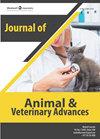不同解冻时间和高温对冻融公牛精液性状的影响
引用次数: 3
摘要
本研究旨在探讨高温解冻和解冻后冷休克对冷冻公牛精液精子活力及顶体和总异常的影响。4头荷斯坦公牛用0.25 mL的吸管冷冻精液。每头公牛的精液在37°C条件下解冻45秒(A组=对照组),在50°C条件下解冻15秒(B组),在70°C条件下解冻5秒(C组),所有组解冻后冷休克(5°C条件下300秒)。精子运动和形态学检查完成后,将精子样本在35℃下孵育120分钟,并重复精子学特征。根据培养基条件(改良的Hepes缓冲培养基)和精子到达受精部位所需的时间,将对照组和实验组的精液样本置于培养箱中。运动率和形态缺陷率采用相差显微镜测定,运动率和速度采用精子生育分析仪(SFA-500)测定。用汉考克液对精子(顶体、其他和全部)进行形态学检查。在计算机辅助精子生育分析仪中,根据该技术进行了精子的运动和运动。综上所述,常规解冻方法和快速解冻技术是成功的方法,其中解冻方法适用于B组受损精子的生存能力。B组的解冻速度并不能保护精子免受溶解或冷休克的有害影响。本文章由计算机程序翻译,如有差异,请以英文原文为准。
Effect of Different Thawing Time and High Temperature on Frozen Thawed Bull Semen Traits
: In this study was to investigate the effect of high temperature thawing and post-thaw cold shock application on sperm motility as well as acrosomal and total abnormalities of frozen bull semen. Four Holstein bulls were used to frozen semen in 0.25 mL straws. Semen of each bulls were thawed in 45 sec at 37°C (Group A = Control group) in 15 sec at 50°C (Group B) and 5 sec at 70°C (Group C) and post-thawing cold shock (300 sec at 5°C) were applied to all groups. After spermatozoa motility and morphological examinations are performed sperm samples were incubated at 35°C for 120 min and spermatological traits were repeated. Semen samples from the control and treatment groups were placed in an incubator taking into consideration the medium conditions (Modified buffered Hepes medium) and the time needed for spermatozoa to reach the fertilization site. Motility and morphological defects rates were determined with phase contrast microscopy and motility rate and speed with sperm fertility analyser (SFA-500). The Hancock’s solution was used for morphologic examination of spermatozoa (acrosome, other and total). In computer aided sperm fertility analyser, motility and movement were performed in according to the technique. In conclusion, it has been found that the conventional thawing method and rapid thawing technique are successful methods where the thawing method applied to Group B damaged spermatozoon viability. The rate of thawing in Group B did not protect the spermatozoa from dissolving or from the harmful effects of cold shock.
求助全文
通过发布文献求助,成功后即可免费获取论文全文。
去求助
来源期刊
自引率
0.00%
发文量
0
审稿时长
1 months
期刊介绍:
Journal of Animal Veterinary advances is a peer-reviewed, open-access scientific journal which publishes articles related to experiments, treatment, analysis, biological elements and other methods of research connected with veterinary. JAVA started publishing activity in 2002, since that time is updated twice a month, and is available in online and print formats. The publications are reviewed by Editorial Board in accordance with the standards and novelty of the subject, while strictly following ethical guidelines. Subject areas suitable for publication include, but are not limited to the following fields :: Veterinary science :: Animal husbandry :: Animal nutrition :: Anatomy :: Biological science :: Pathology :: Infectious diseases :: Animal physiology :: Animal breeding :: Animal biotechnology :: Transgenic animal production :: Animal parasitology :: Veterinary medicine :: Animal feed and nutrition :: Equine.

 求助内容:
求助内容: 应助结果提醒方式:
应助结果提醒方式:


